New Energy Vehicle Thermal Management System Market Research Report, 2024
xEV thermal management research: develop towards multi-port valve + heat pump + liquid cooling integrated thermal management systems.
The thermal management system of new energy vehicles evolves from the decentralized to the integrated, and then to the intelligent:
Distributed thermal management system: simple structure but low efficiency. The circuits of battery, motor and ECU, and air conditioning system are independent of each other. Although the structure is simple, the energy efficiency is low and the integration is also low;
Integrated thermal management system: use multi-port valves or pipelines to connect various systems. By using multi-port valves or pipelines, the circuits of various systems are connected to form a large circulation loop, improving the energy efficiency;
Intelligent thermal management system: the future development trend, realizing the integration of thermal management system functions, modular structure, and intelligent control to achieve the lowest energy consumption and optimal energy distribution for vehicles.
Installation of heat pump systems in new energy passenger cars
There are 368 new energy passenger car models (EV&PHEV&REEV) on sale, including 240 battery electric passenger car models (EV), 106 plug-in hybrid electric passenger car models (PHEV), and 22 range-extended electric passenger car models (REEV). By heat pump installation, battery electric passenger car models account for 47.5%, plug-in hybrid passenger car models 6.6%, and range-extended electric passenger car models 4.5%.
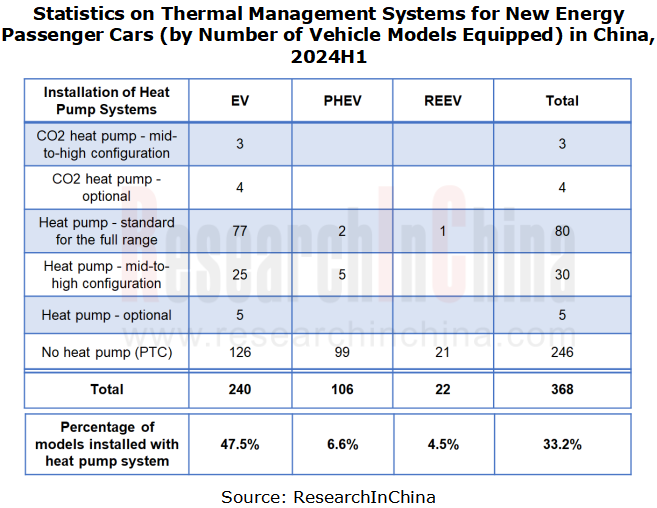
From January to June 2024, a total of 4.689 million new energy passenger cars (EV&PHEV&REEV) were sold. The full range of models installed with heat pump systems as standard took up 31.3% of the total sales; mid-to-high-configuration models with heat pump systems accounted for 6.4%; the models without heat pump systems but using PTC systems swept 62.3% (of which, about 1.3% of the models could be upgraded with optional heat pumps).
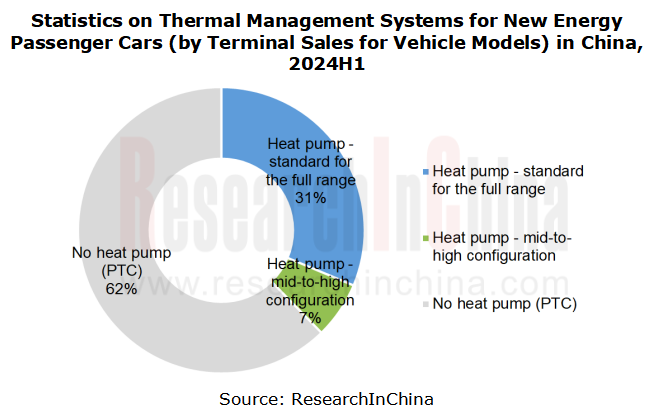
Seen from the price range of China's battery electric (EV) passenger cars (models equipped with heat pumps) in the first half of 2024, 586,000 units of models in the range of RMB200,000-250,000 were sold, making up 37.6% of the total sales of battery electric passenger cars; the sales of models in the range of RMB100,000-150,000 ranked second, up to 354,000 units, or 22.7% of the total sales; the models in the range of RMB150,000-200,000 were positioned third, with sales up to 207,000 units, or 13.2% of the total sales.
The overall selling price of battery electric passenger cars equipped with heat pump systems declines compared to 2023, mainly due to the price war among new energy passenger car manufacturers. As thermal management systems tend to be homemade, the system cost continues to fall.
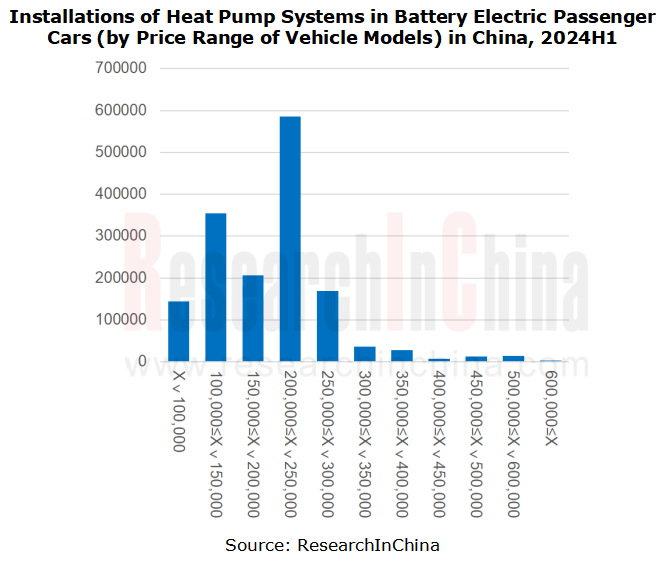
The OEM thermal management system adopts a multi-way valve + heat pump + liquid cooling solution
As new energy vehicle technology advances, thermal management systems also keep innovating and improving. For example, some advanced thermal management systems adopt more intelligent control strategies, automatically adjusting the heat dissipation intensity according to actual conditions. The application of new materials and new technologies has also improved the efficiency and reliability of thermal management systems.
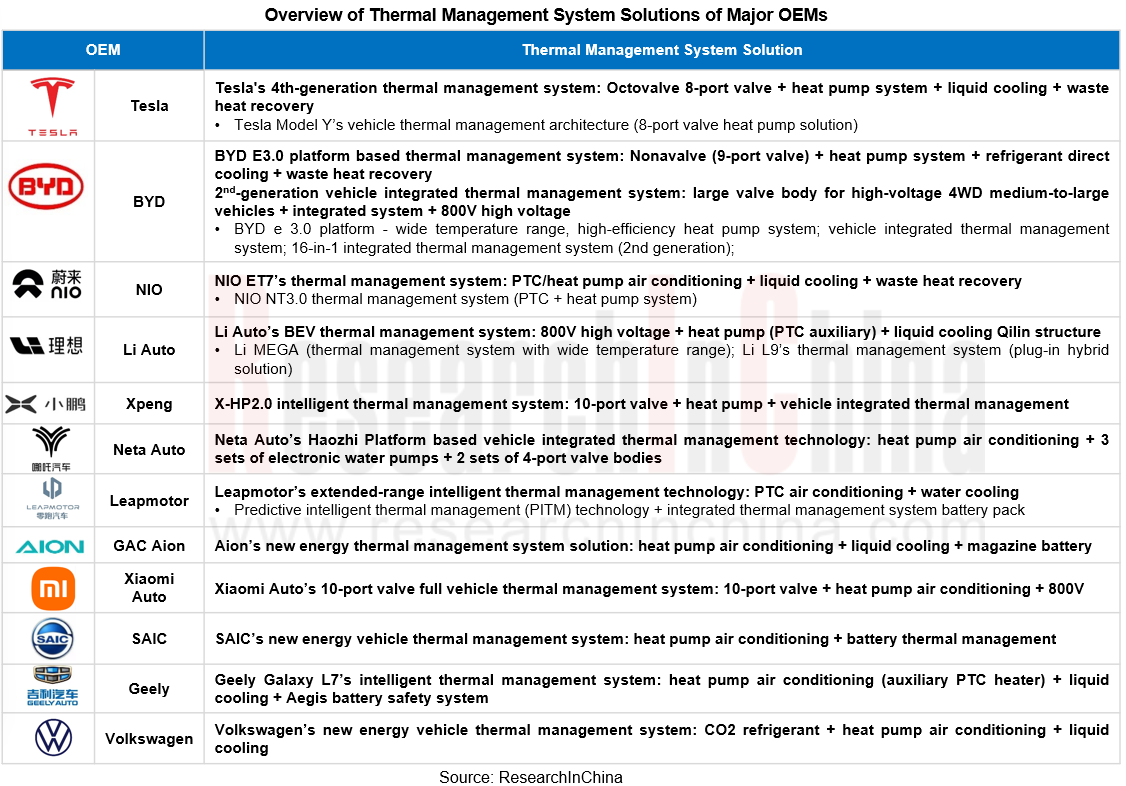
Li Auto
The design concept of Li Auto's thermal management system is multi-port valve + heat pump + waste heat recovery. The super thermal management module integrates 16 main functional components such as valve body, pump, gas separator and heat exchanger, reducing a lot of system components and realizing the separation of physical components and ECUs.
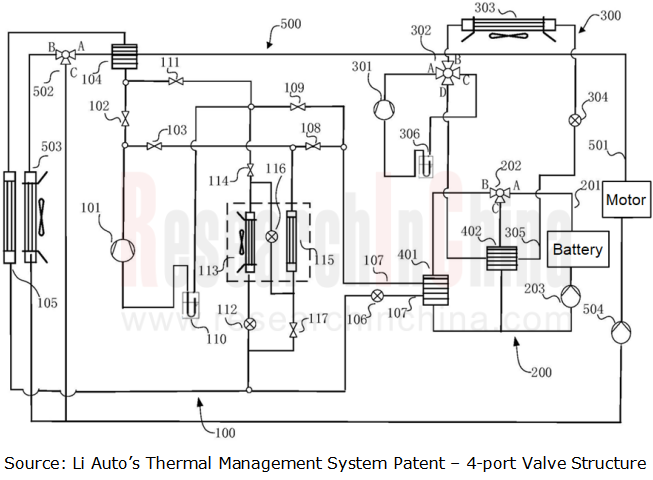
BYD's "16-in-1" integrated thermal management system
The integrated thermal management system based on the BC series heat pump air conditioner under the e-platform 3.0 architecture first reduces energy consumption and loss. It not only enables cold and heat interactions around the cabin and power battery, but also is controlled by the operating system BYD OS at the domain control level, sending cold air directly to the blade battery and cabin, and transferring heat among the electric drive system, cabin and blade battery.
The "16-in-1" integrated thermal management system matching Seal 07 EV can provide high-temperature heating, high-temperature cooling, low-temperature preheating, waste heat recovery and low-temperature refrigeration servo in the five temperature requirements for each system of the vehicle.
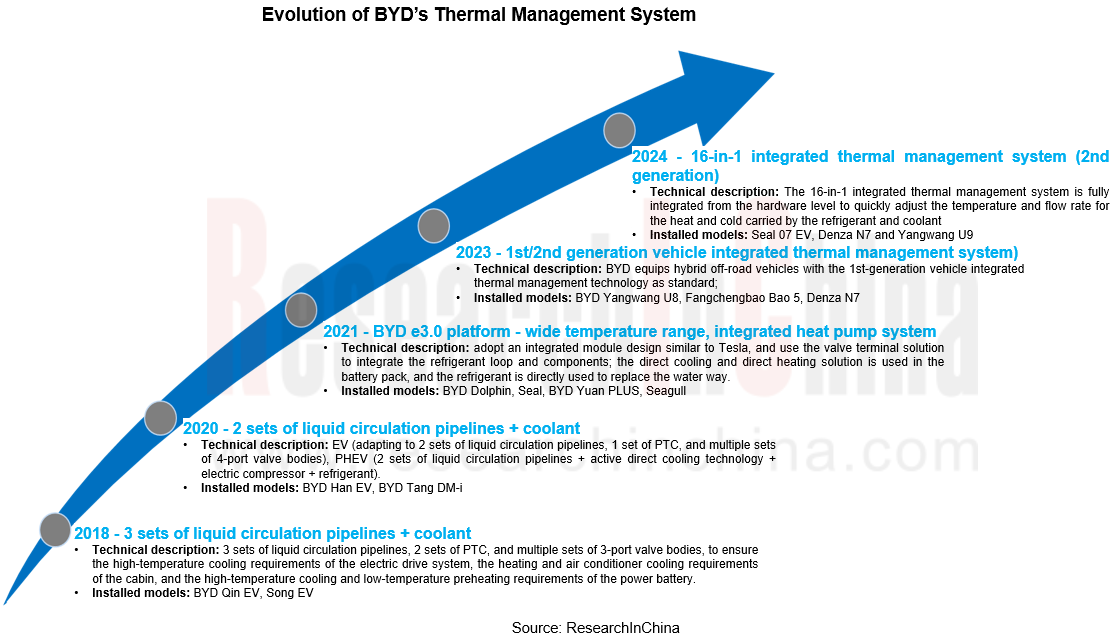
Neta Haozhi Thermal Control - Haozhi Platform Integrated Thermal Management System
Haozhi Thermal Control highlights heat pump air conditioning technology, and features low energy consumption, wide temperature range, and high integration. With heating power consumption less than 800W, it increases cruising range by up to 20% in winter. In addition, the operating temperature of the Haozhi thermal control system is as low as -35℃, and -20℃ in heat pump mode. It has an integrated module and a dual-source heat pump, and supports 3C fast charging.
Haozhi Thermal Control 1.0 is equipped with an integrated module and a dual-source low-temperature heat pump, allowing the battery to be charged fully within half an hour;
Haozhi Thermal Control 2.0 adopts a direct heat pump architecture, uses compressor hot gas bypass technology, and is equipped with an intelligent control algorithm, allowing the battery to be charged fast and fully within 15 minutes;
Haozhi Thermal Control 3.0 uses a new type of coolant, and leads the industry in terms of integration, efficiency and temperature range.
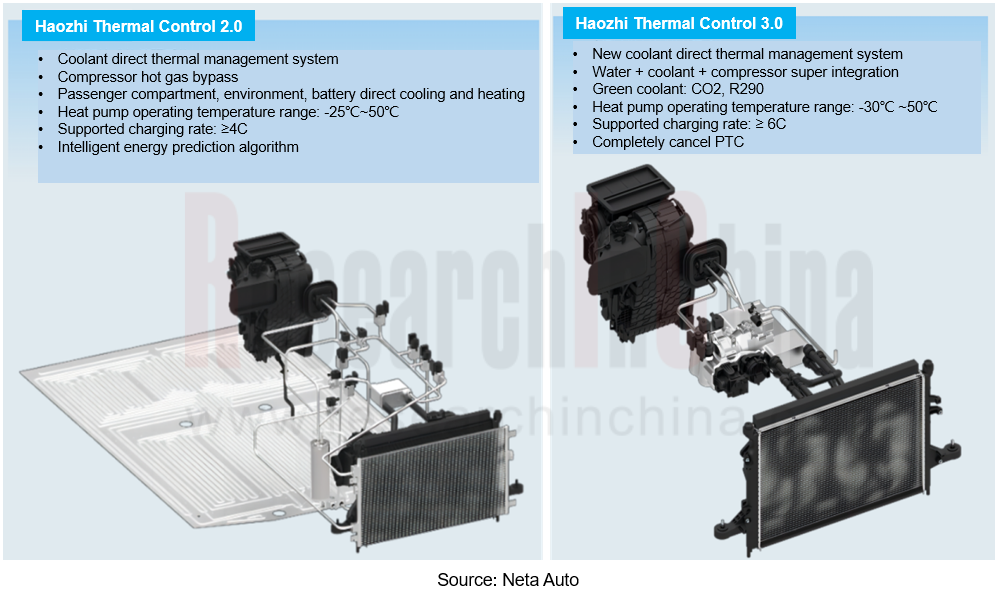
Intelligent thermal management: Innovative solutions such as integrated controllers and sensors spring up.
Thermal management controller - mainstream integrated modules include: water pump drive, water valve drive, electronic expansion valve drive, solenoid valve control, sensor acquisition, network communication, circuit self-diagnosis, OBD diagnosis, hardware, etc.
For example, EVPT's thermal management module (TMM) uses NXP FS32K146 as the main control chip, with bus frequency of 80 MHz, and a connector with 80 Pins (40+40). It offers IP5K1 protection and supports the ISO26262 ASIL-B functional safety level.
Under zonal architecture, zones re-integrate the vehicle power grid architecture, communication architecture and controller architecture. Faced with the trend towards thermal management system integration, the independent thermal management controller can integrate the control systems of core components such as electronic expansion valve, water pump, and water valve into the thermal management controller (TMC). On the one hand, it can reduce a large number of discrete backplane drivers and save system costs. On the other hand, it can ensure the platformization of the vehicle architecture and zone control modules as much as possible while coping with diversified topology architectures of the thermal management system. The integrated thermal management controller can also greatly lower the failure rate of component ECUs, facilitating system intelligence and full life cycle diagnosis and maintenance.
In the future, the main challenges in integrated thermal management systems for new energy vehicles include inaccurate temperature control and energy waste. To solve the problems, it is necessary to further research and develop more advanced temperature and pressure sensing technologies to improve the accuracy and sensitivity of temperature and pressure monitoring.
As MEMS sensors are used ever more widely in vehicles, OEMs need to seize the opportunity and establish industrial partnerships in a short time, so that these new sensor technologies can be successfully integrated into vehicle design.
TDK’s temperature and pressure integrated sensor
It integrates both temperature and pressure measurement functions, and features high accuracy, small size, light weight, quick response, and diverse installation modes. It can be applied to key components such as thermal management systems and automotive electric compressors to monitor heat exchange efficiency in real time.
Melexis MEMS digital output pressure sensor MLX90834
In September 2024, Melexis, a global microelectronics engineering company, expanded its TriphibianTM family with the MLX90834 pressure sensor, designed for automotive applications such as EV thermal management. This robust, factory-calibrated MEMS solution accurately measures pressure in both gas and liquid media from 2 to 70 bar. Its digital SENT output delivers absolute pressure information, diagnostic and temperature data, enabling enhanced system performance and reliability.
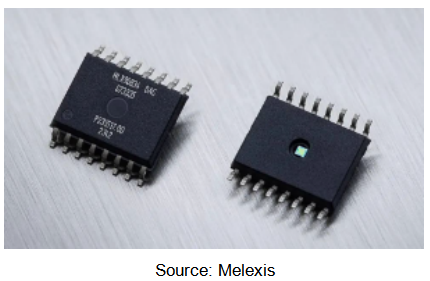
Reliability is the basic requirement for the development of thermal management systems for new energy vehicles. As the new energy vehicle market continues to expand, the reliability requirements for thermal management systems are becoming ever higher. Using high-quality components and strict manufacturing processes, as well as sufficient testing and verification can ensure the stability and reliability of thermal management systems, thereby improving competitive edges of vehicles.
1 Introduction and Policy of New Energy Vehicle Thermal Management System
1.1 Definition and Classification of New Energy Vehicle Thermal Management System
1.1.1 Definition of New Energy Vehicle Thermal Management System
1.1.2 Traditional/New Energy Vehicle Thermal Management System - Structure
1.1.3 Traditional/New Energy Vehicle Thermal Management System - Air Conditioning System
1.1.4 Traditional/New Energy Vehicle Thermal Management System - Engine, Transmission and Auxiliary System Thermal Management
1.1.5 Traditional/New Energy Vehicle Thermal Management System - EIC System Thermal Management
1.1.6 New Energy Vehicle Thermal Management System - Major Components
1.1.7 New Energy Vehicle Thermal Management System - Industry Chain Structure
1.2 Policies Concerning New Energy Vehicle Thermal Management System
1.2.1 Preferential Subsidy Policies for New Energy Vehicles in Major Countries
1.2.2 Major Global OEMs’ Plans to Ban the Sale of New Energy Vehicles
1.2.3 National New Energy Vehicle Thermal Management Safety Regulatory Policy
1.2.4 New Energy Vehicle Thermal Management System Industry Standards - Air Conditioning System
1.2.5 New Energy Vehicle Thermal Management System Industry Standards -Power Battery
1.2.6 New Energy Vehicle Thermal Management System Industry Standards - Other Key Components
1.3 Development Trends of New Energy Vehicle Thermal Management System
1.3.1 Development Trends of China's New Energy Vehicle Thermal Management System Market
1.3.2 Trends of New Energy Vehicle Thermal Management System
2 Status Quo and Trends of New Energy Vehicle Thermal Management Market
2.1 Global New Energy Vehicle Sales Forecast
2.1.1 Global New Energy Vehicle Policies and Incentives
2.1.2 Global New Energy Vehicle Decade Sales Forecast
2.1.3 Global New Energy Vehicle Sales
2.1.4 Global New Energy (EV + PHEV) Passenger Car Sales
2.1.5 Global New Energy (EV + PHEV) Passenger Car Sales - by Brand
2.1.6 Global New Energy (EV + PHEV) Passenger Car Sales - by Model
2.2 China’s New Energy Vehicle Sales/Ownership
2.2.1 China’s Vehicle Sales
2.2.2 China’s Motor Vehicle/Automobile Ownership
2.2.3 China’s Overall Production and Sales of New Energy Vehicles
2.2.4 China’s Overall Production and Sales of New Energy Vehicles - by Fuel Type
2.2.5 China’s New Energy Passenger Car Sales
2.2.6 China’s New Energy Commercial Vehicle Sales
2.3 China’s Automotive Thermal Management System Market Size
2.3.1 China’s New Energy Vehicle Thermal Management System Market Size
2.3.2 China New Energy Vehicle Thermal Management System Penetration Rate
2.3.3 China's New Energy Vehicle Thermal Management System Market Size Forecast
2.3.4 Heat Pump Systems in Models on Sale in 2024 - Installations
2.3.5 Heat Pump Systems in Models on Sale in 2024 - Sales Volume
2.3.6 Heat Pump Systems in Models on Sale in 2024 – Selling Price/Sales Distribution
2.3.7 Heat Pump Systems in Models on Sale in 2024 – Sales/Price List of Installed Models (1)
2.3.8 Heat Pump Systems in Models on Sale in 2024 – Sales/Price List of Installed Models (2)
2.3.9 Heat Pump Systems in Models on Sale in 2024 – Sales/Price List of Installed Models (3)
2.4 Cost of New Energy Vehicle Thermal Management System
2.4.1 Cost Structure of New Energy Vehicle Thermal Management System
2.4.2 Content Per-car Value of Thermal Management System for New Energy Vehicles Is About 2-3 Times Higher Than Traditional Vehicles
2.5 New Energy Vehicle Thermal Management System Competitive Pattern
2.5.1 Key Components of New Energy Vehicle Thermal Management System
2.5.2 Main Products and Customers of New Energy Vehicle Thermal Management System Suppliers
2.5.3 Comparison of Technical Features between Thermal Management System Companies
2.6 New Energy Truck Thermal Management System
2.6.1 Light New Energy Trucks Are Implemented Earlier Than Other Types of New Energy Commercial Vehicles
2.6.2 Development of Thermal Management Systems for Commercial Vehicles Lags behind Passenger Cars
2.6.3 Light New Energy Truck Thermal Management System
2.6.4 Development Trends of Light New Energy Truck Thermal Management System Architecture
2.6.5 Light New Energy Truck Thermal Management - Technical Architecture
2.6.6 Typical Light New Energy Truck Models with Thermal Management: Yutong T5 Battery Electric Light Truck
2.6.7 Typical Light New Energy Truck Models with Thermal Management: BYD T5 Hybrid (Longitudinal REEV) Light Truck
2.6.8 Light New Energy Truck Thermal Management - Components Suppliers List
2.6.9 Light New Energy Truck Thermal Management System Cases
2.6.10 Light New Energy Truck Thermal Management System: Electric Compressor
2.6.11 FAW Jiefang Hybrid Heavy Truck: Thermal Management Integrated System
2.7 Fuel Cell Vehicle Thermal Management System
2.7.1 Fuel Cell Thermal Management System - Core Components of Passenger Cars
2.7.2 Fuel Cell Thermal Management System - Core Components of Commercial Vehicles
2.7.3 Fuel Cell Thermal Management System - Structural Diagram
2.7.4 Fuel Cell Thermal Management System - Cooling Control Strategy
2.7.5 Fuel Cell Vehicle Thermal Management System - Components Suppliers List
2.7.6 Fuel Cell Vehicle Thermal Management System - Latest Patents
2.7.7 FAW Jiefang Fuel Cell Truck: Thermal Management Integrated System
3 New Energy Vehicle Thermal Management Industry Chain
3.1 New Energy Vehicle Thermal Management System Integration
3.1.1 New Energy Vehicle Thermal Management System Integration Solution - Development Trends
3.1.2 New Energy Vehicle Thermal Management System - Components
3.1.3 Thermal Management System - System Integration Structure
3.1.4 Thermal Management System - System Integration: Business and Product Progress of Core Suppliers
3.2 New Energy Vehicle Thermal Management System - PTC Heater
3.2.1 Development Trends of New Energy Vehicle PTC/Heat Pump Air Conditioner
3.2.2 Air Conditioning System of PTC Air Heater
3.2.3 Electric PTC Heater
3.2.4 Classification and Application of PTC Heater
3.2.5 Comparison between Typical PTC Heater Products
3.2.6 Application Cases of PTC Heater in Heat Pump Air Conditioning System
3.2.7 PTC Heater Development Trends and Scale Forecast
3.2.8 Thermal Management System - PTC Heater: Business and Product Progress of Core Suppliers
3.2.9 Thermal Management System - 800V Heater: Business and Product Progress of Core Suppliers
3.2.10 800V Liquid Heater - Product Case
3.3 New Energy Vehicle Thermal Management System - Heat Pump Air Conditioner
3.3.1 New Energy Vehicle Heat Pump Air Conditioner - Working Principle
3.3.2 New Energy Vehicle Heat Pump Air Conditioner - Structure
3.3.3 New Energy Vehicle Heat Pump Air Conditioner - Components
3.3.4 New Energy Vehicle Heat Pump Air Conditioner - Vehicle Assembly
3.3.5 New Energy Vehicle Heat Pump Air Conditioner - Principle of Three-source Heat Pump System
3.3.6 Thermal Management System - Heat Pump Air Conditioner: Core Suppliers and Business Progress
3.3.7 Heat Pump Air Conditioning System Cases - Dolphin Car Heat Pump Air Conditioning System
3.3.8 Heat Pump Air Conditioning System Cases - Tesla Octovalve Highly Integrated 8-port Valve Heat Pump System
3.3.9 Heat Pump Air Conditioning System Cases - Volkswagen MEB Platform Architecture
3.4 New Energy Vehicle Heat Pump Air Conditioning System - Refrigerant
3.4.1 Heat Pump Air Conditioning Refrigerant - Development Stages
3.4.2 Heat Pump Air Conditioning Refrigerant - Environmental Performance
3.4.3 Heat Pump Air Conditioning Refrigerant - Heat Material Performance/Heating Performance Comparison
3.4.4 Heat Pump Air Conditioning Refrigerant - Cost Comparison
3.4.5 CO2 Heat Pump Refrigerant - Core Components
3.4.6 Thermal Management Systems - CO2 Refrigerant Components: Business and Product Progress of Core Suppliers in China
3.4.7 Heat Pump Air Conditioning Refrigerant - Development Route
3.4.8 Heat Pump Air Conditioning Refrigerant - CO2 Technology Route Development
3.4.9 Heat Pump Air Conditioning Refrigerant - Competitive Pattern of CO2 Air Conditioning Pipeline Products Market
3.4.10 CO2 Refrigeration (R744) Technology Prospect
3.4.11 Heat Pump Air Conditioning Refrigerant - Development Opportunities
3.4.12 Heat Pump Air Conditioning Refrigerant - Development Challenges
3.5 New Energy Vehicle Thermal Management System - Battery Thermal Management System
3.5.1 Power Battery Thermal Management System Is the Core of New Energy Thermal Management System
3.5.2 Power Battery Thermal Management System - Air Cooling
3.5.3 Power Battery Thermal Management System - Main Air Cooled Models
3.5.4 Power Battery Thermal Management System - Liquid Cooling
3.5.5 Power Battery Thermal Management System - Main Liquid Cooled Models
3.5.6 Power Battery Thermal Management System - Liquid Cooling VS Direct Cooling
3.5.7 Power Battery Thermal Management System - Direct Cooling
3.5.8 Power Battery Thermal Management System - Main Direct Cooling Models
3.5.9 Battery Thermal Management System - Summary of PACK Cooling Methods
3.5.10 Thermal Management System - Battery Thermal Management: Business and Product Progress of Core Suppliers
3.5.11 Cooling Architecture of Battery Thermal Management System
3.5.12 Battery Thermal Management Solutions at Low Temperature Condition
3.5.13 Battery Thermal Management System Is Greatly Affected by Battery Materials
3.6 New Energy Vehicle Thermal Management System - Electric Compressor
3.6.1 Status Quo of New Energy Vehicle Electric Compressor
3.6.2 Thermal Management System - Electric Scroll Compressor: Structure
3.6.3 Thermal Management System - Electric Scroll Compressor: Technical Evaluation Indicators
3.6.4 Thermal Management System - Electric Scroll Compressor: Working Principle
3.6.5 New Energy Vehicle Electric Compressor - Market Size
3.6.6 Thermal Management System - Electric Scroll Compressor: Market Competition
3.6.7 Thermal Management System - Electric Scroll Compressor: Core Suppliers and Business Progress
3.6.8 Emerging Thermal Management System Electric Compressor Players
3.6.9 Thermal Management System Electric Compressor - New Product Technology Route
3.6.10 New Electric Compressor Product Solution: Shanghai Everland R744 Ultra-low Temperature Heat Pump Compressor
3.6.11 MAHLE Thermal Management Solutions: High Pressure PTC Heater, 800V 57cc Electric Compressor
3.7 New Energy Vehicle Thermal Management System - Electronic Expansion Valve
3.7.1 New Energy Vehicle Electronic Expansion Valve - Product Structure
3.7.2 Thermal Management System - Electronic Expansion Valve: Business and Product Progress of Core Suppliers
3.7.3 New Energy Vehicle Electronic Expansion Valve - Product Case
3.8 New Energy Vehicle Thermal Management System - Heat Pump Integrated Valve
3.8.1 New Energy Vehicle Heat Pump Integrated Valve - Structure
3.8.2 New energy vehicle heat pump integrated valve - 4-port Valve
3.8.3 New Energy Vehicle Thermal Management System - Multi-port Valve Has Become the Main Development Direction of Heat Pump Systems of OEMs
3.8.4 Thermal Management System - Heat Pump Multi-port Valve: Business and Product Progress of Core Suppliers
3.8.5 New Energy Vehicle Heat Pump Integrated Valve - BYD Dolphin Thermal Management Integrated Valve
3.8.6 New Energy Vehicle Heat Pump Integrated Valve - Tesla Octovalve
3.8.7 New Energy Vehicle Heat Pump Integrated Valve - Tuopu 9-port Valve
3.8.8 New Energy Vehicle Heat Pump Integrated Valve - Commercial Vehicle Heat Pump Integrated Valve
3.9 New Energy Vehicle Thermal Management System - Electronic Water Pump
3.9.1 New Energy Vehicle Electronic Pump
3.9.2 Classification
3.9.3 Structural Design
3.9.4 Technical Parameters
3.9.5 Market Size Forecast
3.9.6 Thermal Management System - Electronic Water Pump: Business and Product Progress of Core Suppliers
3.9.7 Smart Water Pump Case
3.10 New Energy Vehicle Thermal Management System - Electronic Fan
3.10.1 New Energy Vehicle Electronic Fan - Product Structure
3.10.2 Thermal Management System - Electronic Fan: Business and Product Progress of Core Suppliers
3.10.3 New Energy Vehicle High Voltage Electronic Fan - Product Case
3.11 New Energy Vehicle Thermal Management System - Pipeline
3.11.1 Status Quo of Pipeline
3.11.2 Classification of Pipeline Materials
3.11.3 Nylon Coolant Pipeline
3.11.4 Cooling Water Pipe Materials
3.11.5 Cooling Water Pipe Performance Comparison
3.11.6 Thermal Management System - Pipeline: Business and Product Progress of Core Suppliers
3.11.7 Thermal Management System - Pipeline: New Product Technology Route
3.12 New Energy Vehicle Thermal Management System - Thermal Management Controller
3.12.1 New Energy Vehicle Thermal Management Controller
3.12.2 Thermal Management System Functional Modules
3.12.3 New Energy Vehicle Thermal Management Controller – Battery Electric Vehicle
3.12.4 New Energy Vehicle Thermal Management Controller - Plug-in Hybrid Electric Vehicle
3.12.5 Function Modules
3.12.6 Hardware Requirements
3.12.7 Integration under Zonal Framework
3.12.8 MCU Circuit
3.12.9 Thermal Management Control System Case
3.12.10 Thermal Management System - Thermal Management Controller: Business and Product Progress of Core Suppliers
3.12.11 Supplier Case
3.12.12 Vehicle Case
3.12.13 Development Trends
3.13 New Energy Vehicle Thermal Management System - Intelligent Pressure/Temperature Sensor
3.13.1 New Energy Vehicle Pressure/Temperature Sensor
3.13.2 Intelligent Pressure/Temperature Sensor: Business and Product Progress of Core Suppliers
3.13.3 Supplier Case
4 New Energy Vehicle Thermal Management System Suppliers
4.1 Denso
4.1.1 Profile
4.1.2 Automotive Thermal Management System Products (1)
4.1.3 Automotive Thermal Management System Products (2)
4.1.4 Automotive Thermal Management Solutions
4.1.5 Heat Pump System
4.1.6 Introduction to Heat Pump System Technology
4.1.7 Heat Pump System Installation Cases
4.1.8 Heat Pump System Development Stages
4.2 MAHLE
4.2.1 Profile
4.2.2 Main Business
4.2.3 Automotive Thermal Management System
4.2.4 Integrated Thermal Management System
..............
4.2.17 Global Layout
4.2.18 China Layout
4.2.19 Suzhou MAHLE: DTS (Direct-Temperature System) Thermal Management System
4.3 Valeo
4.3.1 Profile
4.3.2 Heat Pump Technology
4.3.3 FlexHeaters
4.3.4 Battery Thermal Management System
4.3.5 Thermal Management System in Fast Charging Conditions
4.4 Hanon
4.4.1 Profile
4.4.2 Heat Pump System
4.4.3 Automotive Thermal Management Products: HVAC
4.4.4 Automotive Thermal Management Products: Compressor
4.4.5 Automotive Thermal Management Products: Others
4.4.6 New Energy Vehicle Thermal Management System: Electric Vehicle/Hybrid Electric Vehicle
4.4.7 New Energy Vehicle Thermal Management System: Fuel Cell Vehicle
4.5 Sanden
4.5.1 Profile
4.5.2 Thermal Management System Trends
..............
4.5.7 CO2 Compressor
4.5.8 Other Automotive Thermal Management System Components
4.5.9 Business Distribution
4.6 Continental
4.6.1 Classification of Thermal Management Systems
4.6.2 Vehicle System-level Thermal Management Optimization Strategy
4.6.3 Battery Thermal Management Technology
4.6.4 New Energy Vehicle Thermal Management System Production Bases
4.7 Aotecar
4.7.1 Profile
4.7.2 Electric Vehicle Air Conditioning Compressor Products
4.7.3 Electric Vehicle Air Conditioning Compressor Product Parameters
4.7.4 Automotive Air Conditioning System
4.7.5 Low-temperature Heat Pump System
4.7.6 Production and Sales of Thermal Management Systems
4.7.7 Major Customers of New Energy Vehicle Thermal Management Systems
4.8 Yinlun Machinery
4.8.1 Profile
4.8.2 Automotive Thermal Management Business
4.8.3 Automotive Thermal Management Products
..............
4.8.9 New Energy Commercial Vehicle Thermal Management System
4.8.10 Emerging Thermal Management Fields
4.8.11 Global Layout
4.9 Sanhua Intelligent Controls
4.9.1 Profile
4.9.2 Capacity, Output and Classification of New Energy Vehicle Thermal Management System Products
4.9.3 Automotive Electronic Expansion Valve
4.9.4 Automotive Electronic Water Pump
4.9.5 Other Automotive Thermal Management Products
4.9.6 New Auto Parts Projects
4.9.7 Business Scope
4.10 Songz Automobile Air Conditioning
4.10.1 Profile
4.10.2 Production and Sales of New Energy Vehicle Thermal Management Products
4.10.3 Related Products of Small Vehicle Thermal Management Division
..............
4.10.10 R&D Trends of Thermal Management Systems for Energy Storage Systems
4.10.11 Vehicle Partners
4.11 HASCO
4.11.1 Profile
4.11.2 Thermal Management System
4.11.3 Classification and Supply of New Energy Vehicle Thermal Management Systems
..............
4.11.10 Shanghai MAHLE - Main Customers of Electric Air Conditioning and Thermal Management System
4.11.11 Shanghai MAHLE - Layout of Electric Air Conditioning and Thermal Management System
4.11.12 Other Thermal Management System Components
4.12 Tenglong Auto Parts
4.12.1 Profile
4.12.2 Automotive Thermal Management System Business Model
4.12.3 Automotive Thermal Management System Products
4.12.4 Major Customers
4.12.5 R&D Center, Production Base
4.13 Feilong Auto Components
4.13.1 Profile
4.13.2 Electronic Water Pump Products
4.13.3 Thermal Management Integrated Module
4.13.4 Major New Energy Customers
4.14 Kelai Mechatronics
4.14.1 Profile
4.14.2 New Energy Vehicle Components Business Model
4.14.3 Cooling Water Pipes
4.14.4 R744 High-Pressure Air Conditioning Pipeline and Valve Parts
4.14.5 Major Customers and Technologies
4.15 DUNAN Artificial Environment
4.15.1 Profile
4.15.2 New Energy Vehicle Thermal Management Business
4.15.3 New Energy Vehicle Thermal Management Products
4.15.4 New Energy Vehicle Thermal Management Unit
4.15.5 Large Diameter Electronic Expansion Valve
4.15.6 Thermal Management R&D Trends
4.16 Midea Welling Car
4.16.1 Business Development Route
4.16.2 Thermal Management System Products
4.16.3 Thermal Management Integrated Module (Large Integration)
4.16.4 A00 Electric Compressor (Innovative Rotor Type)
4.16.5 800V Silicon Carbide (SiC) High Speed ??Electric Compressor
4.16.6 R134a Scroll Electric Compressor, CO2 Refrigerant Electric Compressor
4.16.7 Electronic Water Pump, Electronic Oil Pump
4.16.8 Production Base and Customers
4.17 Baling Technology
4.17.1 Profile
4.17.2 New Energy Vehicle Thermal Management System Products
4.17.3 New Energy Vehicle Thermal Management System Capacity
4.17.4 New Energy Vehicle Thermal Management System R&D Projects
4.17.5 Main Customers of New Energy Vehicle Thermal Management System
4.18 Huawei
4.18.1 Thermal Management Solution TMS: Appearance and Structure
4.18.2 Thermal Management Solution TMS: Integrated Design
4.18.3 Thermal Management Solution Patents
4.18.4 Thermal Management Solution Design Idea
4.19 Zhongding
4.19.1 Profile
4.19.2 New Energy Thermal Management System Pipeline Products
4.19.3 Battery Cooling System Pipeline
4.19.4 Sealing System
4.19.5 Core Technologies of New Energy Thermal Management System Pipeline
4.19.6 Global Layout
4.20 Sensata Technologies
4.20.1 Development in China
4.20.2 New Energy Vehicle Products
..............
4.20.7 Automotive Electrical Safety Monitoring Equipment
4.21 UAES
4.21.1 New Energy Thermal Management System
4.22 Langxin Electric
4.22.1 New Energy Thermal Management Customers
4.22.2 Thermal Management System Products
4.22.3 Thermal Management System Application Areas
5 Thermal Management System Solutions of OEMs
5.1 Tesla
5.1.1 Development Stages of Automotive Thermal Management System
5.1.2 Thermal Management System Technology Route
5.1.3 Thermal Management System Patents
..............
5.1.14 8-port Valve Heat Pump Solution in Model Y
5.1.15 Summary of 4th-generation Thermal Management System Model
5.2 BYD
5.2.1 Introduction to New Energy Vehicle Thermal Management
5.2.2 Development Stages of Automotive Thermal Management System
5.2.3 BYD E3.0 Wide Temperature Range High-efficiency Heat Pump System
..............
5.2.15 Seal’s Thermal Management System
5.2.17 Yangwang U8 and Fangchengbao Bao 5 Vehicle Integrated Thermal Management System
5.2.18 Seak 07 EV’s "16-in-1" Integrated Thermal Management Technology
5.3 NIO
5.3.1 Development Stages of Automotive Thermal Management System
5.3.2 ET7 Thermal Management System
5.3.3 ES6 Thermal Management System
5.3.4 ES8 Thermal Management System
5.3.5 Thermal Management System Patents
5.4 Li Auto
5.4.1 Development Stages of Automotive Thermal Management System
5.4.2 Li MEGA’s Thermal Management System
5.4.3 Li L9’s Thermal Management System Supplier
5.4.4 800V Wide Temperature Range Thermal Management System
5.4.5 4-port Valve Thermal Management System Solution
5.4.6 Thermal Management System Patents
5.5 Xpeng
5.5.1 Development Stages of Automotive Thermal Management System
5.5.2 X-HP2.0 Intelligent Thermal Management System
5.5.3 X-HP Intelligent Thermal Management System
5.5.4 P7i Vehicle Thermal Management Solution (10-port Valve Integrated Heat Pump)
5.5.5 X9 Thermal Management System
5.5.6 P7 Vehicle Thermal Management Solution (PTC Electric Heating Solution)
5.5.7 P7 Vehicle Thermal Management Solution (Major Component Suppliers)
5.5.8 P7 Battery Thermal Management System
5.5.9 Vehicle Thermal Management Technology Patents
5.6 Xiaomi Auto
5.6.1 Xiaomi SU7 Thermal Management System
5.6.2 Three-heat Source Step-by-step Heating Technology
5.6.3 Battery Thermal Management
5.6.4 10-port Valve Full Vehicle Thermal Management System
5.6.5 Thermal Management System Layout
5.6.6 Thermal Management System Patents
5.7 Neta Auto
5.7.1 Development Stages of Automotive Thermal Management System
5.7.2 HozonEPT2.0 Constant Temperature Thermal Management System
..............
5.7.11 Haozhi Thermal Control 2.0-3.0
5.7.12 Huawei 9-port Valve Heat Pump in Neta S
5.7.13 Thermal Management System Patents
5.8 Leapmotor
5.8.1 Development Stages of Automotive Thermal Management System
5.8.2 Leapmotor C11 Extended-range Vehicle Thermal Management Control System
5.8.3 Predictive Intelligent Thermal Management (PITM) Technology
5.8.4 Module-To-Chassis (MTC) Technology
5.8.5 Cell-To-Chassis (CTC) Technology
5.8.6 Leapmotor C16’s Integrated Thermal Management System Battery Pack
5.8.7 Thermal Management System Patents
5.9 GAC Aion
5.9.1 Development Stages of Automotive Thermal Management System
5.9.2 AION LX Thermal Management System
5.9.3 AION S Thermal Management System
5.9.4 Magazine Battery 2.0 Thermal Management
5.9.5 2nd-generation Intelligent Temperature Control System ITS2.0
5.10 SAIC
5.10.1 Development Stages of Automotive Thermal Management System
5.10.2 Rising F7’s Battery Thermal Management System
5.10.3 MARVEL R’s Thermal Management System
5.10.4 Roewe RX5 eMAX’s Thermal Management System
5.10.5 SAIC Roewe’s Thermal Management System
5.10.6 SAIC DMH Super Hybrid Thermal Management System
5.11 Geely
5.11.1 Development Stages of Automotive Thermal Management System
5.11.2 Lynk & Co ZERO Direct Heat Pump System
..............
5.11.9 Galaxy L7’s Thermal Management System
5.11.10 New Energy Thermal Management Strategy
5.12 Dongfeng Group
5.12.1 Development Stages of Automotive Thermal Management System
5.12.2 Dongfeng Quantum Architecture Full-Stack Self-Developed Highly Integrated Thermal Management System
5.12.3 800V+ Integrated Thermal Management System
5.13 Volkswagen
5.13.1 Development Stages of Automotive Thermal Management System
5.13.2 Heat Pump System
5.13.3 Heat Pump System Components: AC Compressor
5.13.4 Heat Pump System Components: Valve Unit Assembly (1)
..............
5.13.15 Thermal Management System of Volkswagen Golf GTE PHEV (2)
5.14 Audi
5.14.1 Development Stages of Automotive Thermal Management System
5.14.2 Electric Vehicle Thermal Management System in Winter (1)
5.14.3 Electric Vehicle Thermal Management System in Winter (2)
..............
5.14.15 Working Mode of e-tron’s Thermal Management System
5.14.16 Thermal Management System of R8 e-tron BEV
5.15 BMW
5.15.1 Development Stages of Automotive Thermal Management System
5.15.2 i4 EV’s Thermal Management System
5.15.3 iX3 EV’s Thermal Management System
5.15.4 i3 EV’s Thermal Management System
.............
5.15.10 BMW X5/BMW i8 Battery Pack Thermal Management System - R134a Direct Cooling
5.15.11 Thermal Management Module of Crankcase Coolant Stop Valve
5.16 SAIC-GM
5.16.1 Development Stages of Automotive Thermal Management System
5.16.2 Ultium’s New Energy Vehicle Thermal Management System
5.16.3 Battery Thermal Management System
5.17 Hyundai
5.17.1 Development Stages of Automotive Thermal Management System
5.17.2 Thermal Management Integrated Module
5.17.3 Hyundai ENQINO EV Thermal Management System
5.17.4 Hyundai IONIQ 5N Thermal Management System
5.18 Toyota
5.18.1 5-Port Valve Vehicle Thermal Management System
5.18.2 Battery Thermal Management System
5.18.3 Fuel Cell Vehicle Thermal Management
5.19 Summary of Thermal Management System Solutions of Main OEMs
5.19.1 Overview of Thermal Management System Solutions of Main OEMs (1)
5.19.2 Overview of Thermal Management System Solutions of Main OEMs (2)
5.19.3 Overview of Thermal Management System Solutions of Main OEMs (3)
5.19.4 Overview of Thermal Management System Solutions of Main OEMs (4)
5.19.5 List of Thermal Management System Suppliers for Key Vehicle Models of OEMs (1)
5.19.6 List of Thermal Management System Suppliers for Key Vehicle Models of OEMs (2)
5.19.7 List of Thermal Management System Suppliers for Key Vehicle Models of OEMs (3)
5.19.8 List of Thermal Management System Suppliers for Key Vehicle Models of OEMs (4)
5.19.9 List of Thermal Management System Suppliers for Key Vehicle Models of OEMs (5)
5.19.10 List of Thermal Management System Suppliers for Key Vehicle Models of OEMs (6)
Autonomous Driving Domain Controller and Central Computing Unit (CCU) Industry Report, 2025
Research on Autonomous Driving Domain Controllers: Monthly Penetration Rate Exceeded 30% for the First Time, and 700T+ Ultrahigh-compute Domain Controller Products Are Rapidly Installed in Vehicles
L...
China Automotive Lighting and Ambient Lighting System Research Report, 2025
Automotive Lighting System Research: In 2025H1, Autonomous Driving System (ADS) Marker Lamps Saw an 11-Fold Year-on-Year Growth and the Installation Rate of Automotive LED Lighting Approached 90...
Ecological Domain and Automotive Hardware Expansion Research Report, 2025
ResearchInChina has released the Ecological Domain and Automotive Hardware Expansion Research Report, 2025, which delves into the application of various automotive extended hardware, supplier ecologic...
Automotive Seating Innovation Technology Trend Research Report, 2025
Automotive Seating Research: With Popularization of Comfort Functions, How to Properly "Stack Functions" for Seating?
This report studies the status quo of seating technologies and functions in aspe...
Research Report on Chinese Suppliers’ Overseas Layout of Intelligent Driving, 2025
Research on Overseas Layout of Intelligent Driving: There Are Multiple Challenges in Overseas Layout, and Light-Asset Cooperation with Foreign Suppliers Emerges as the Optimal Solution at Present
20...
High-Voltage Power Supply in New Energy Vehicle (BMS, BDU, Relay, Integrated Battery Box) Research Report, 2025
The high-voltage power supply system is a core component of new energy vehicles. The battery pack serves as the central energy source, with the capacity of power battery affecting the vehicle's range,...
Automotive Radio Frequency System-on-Chip (RF SoC) and Module Research Report, 2025
Automotive RF SoC Research: The Pace of Introducing "Nerve Endings" such as UWB, NTN Satellite Communication, NearLink, and WIFI into Intelligent Vehicles Quickens
RF SoC (Radio Frequency Syst...
Automotive Power Management ICs and Signal Chain Chips Industry Research Report, 2025
Analog chips are used to process continuous analog signals from the natural world, such as light, sound, electricity/magnetism, position/speed/acceleration, and temperature. They are mainly composed o...
Global and China Electronic Rearview Mirror Industry Report, 2025
Based on the installation location, electronic rearview mirrors can be divided into electronic interior rearview mirrors (i.e., streaming media rearview mirrors) and electronic exterior rearview mirro...
Intelligent Cockpit Tier 1 Supplier Research Report, 2025 (Chinese Companies)
Intelligent Cockpit Tier1 Suppliers Research: Emerging AI Cockpit Products Fuel Layout of Full-Scenario Cockpit Ecosystem
This report mainly analyzes the current layout, innovative products, and deve...
Next-generation Central and Zonal Communication Network Topology and Chip Industry Research Report, 2025
The automotive E/E architecture is evolving towards a "central computing + zonal control" architecture, where the central computing platform is responsible for high-computing-power tasks, and zonal co...
Vehicle-road-cloud Integration and C-V2X Industry Research Report, 2025
Vehicle-side C-V2X Application Scenarios: Transition from R16 to R17, Providing a Communication Base for High-level Autonomous Driving, with the C-V2X On-board Explosion Period Approaching
In 2024, t...
Intelligent Cockpit Patent Analysis Report, 2025
Patent Trend: Three Major Directions of Intelligent Cockpits in 2025
This report explores the development trends of cutting-edge intelligent cockpits from the perspective of patents. The research sco...
Smart Car Information Security (Cybersecurity and Data Security) Research Report, 2025
Research on Automotive Information Security: AI Fusion Intelligent Protection and Ecological Collaboration Ensure Cybersecurity and Data Security
At present, what are the security risks faced by inte...
New Energy Vehicle 800-1000V High-Voltage Architecture and Supply Chain Research Report, 2025
Research on 800-1000V Architecture: to be installed in over 7 million vehicles in 2030, marking the arrival of the era of full-domain high voltage and megawatt supercharging.
In 2025, the 800-1000V h...
Foreign Tier 1 ADAS Suppliers Industry Research Report 2025
Research on Overseas Tier 1 ADAS Suppliers: Three Paths for Foreign Enterprises to Transfer to NOA
Foreign Tier 1 ADAS suppliers are obviously lagging behind in the field of NOA.
In 2024, Aptiv (2.6...
VLA Large Model Applications in Automotive and Robotics Research Report, 2025
ResearchInChina releases "VLA Large Model Applications in Automotive and Robotics Research Report, 2025": The report summarizes and analyzes the technical origin, development stages, application cases...
OEMs’ Next-generation In-vehicle Infotainment (IVI) System Trends Report, 2025
ResearchInChina releases the "OEMs’ Next-generation In-vehicle Infotainment (IVI) System Trends Report, 2025", which sorts out iterative development context of mainstream automakers in terms of infota...